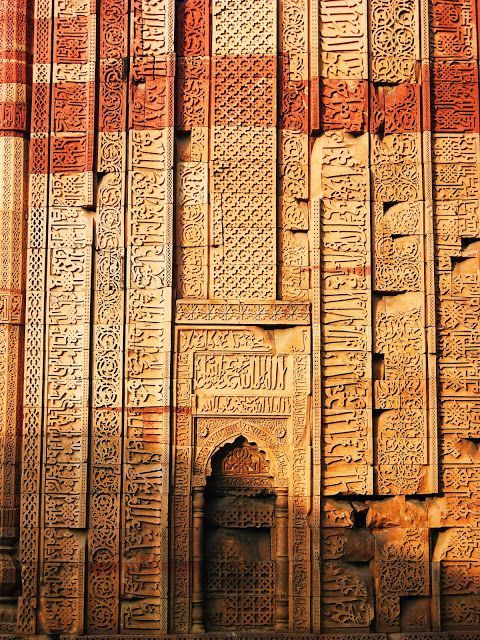#qutb complex
Text
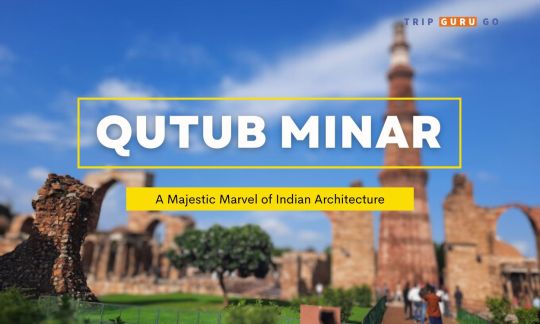
#Qutub Minar#Indian Architecture#UNESCO World Heritage Site#Delhi#India#Indo-Islamic Architecture#Historical Landmark#12th Century Monument#Majestic Tower#Cultural Heritage#Tourist Attraction#Architectural Marvel#Delhi Sightseeing#Qutb Complex#Delhi Tourism#Heritage Conservation
0 notes
Text
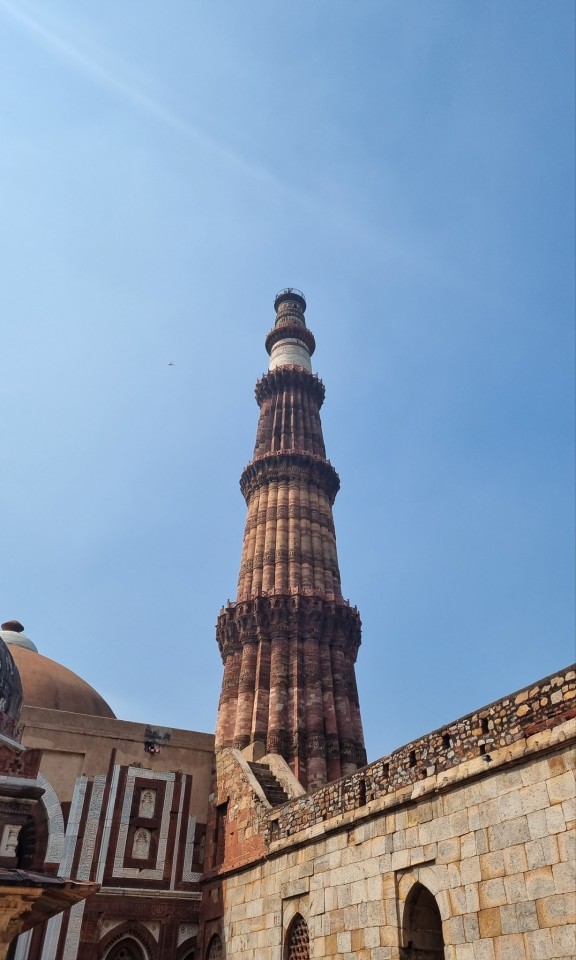
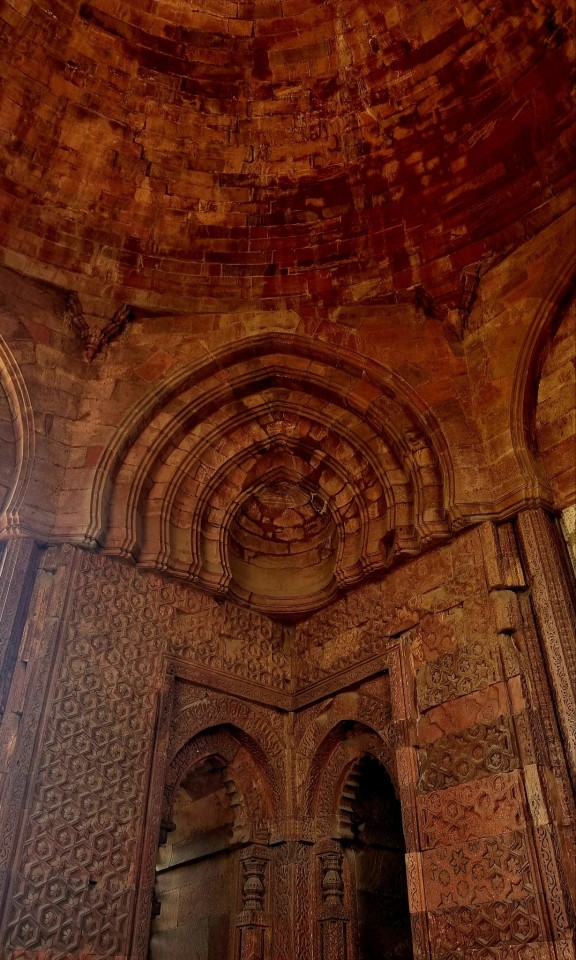
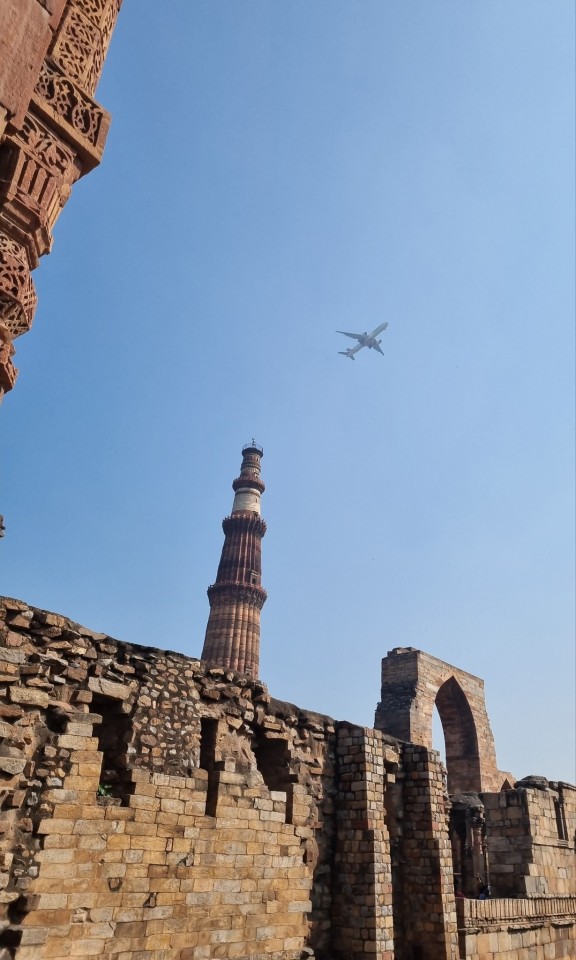
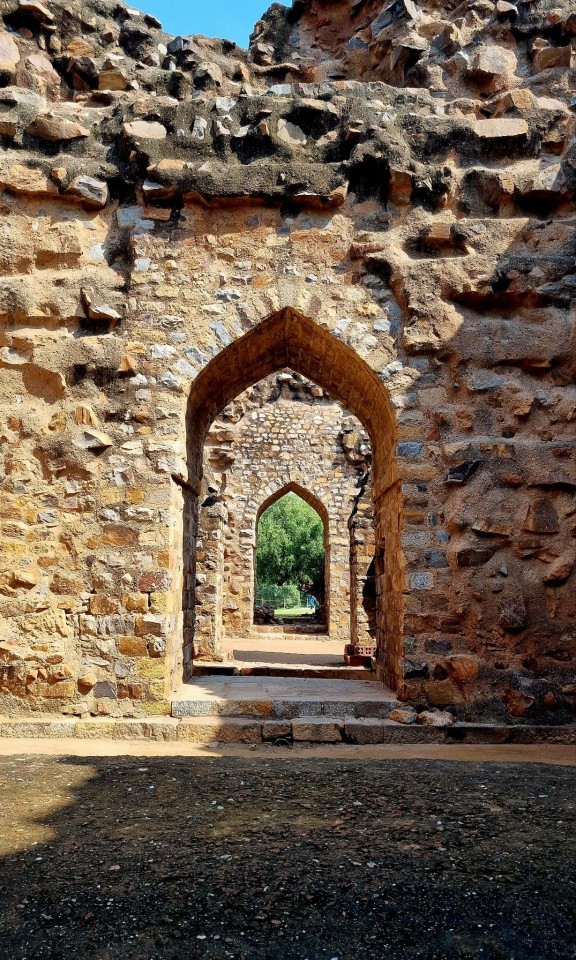
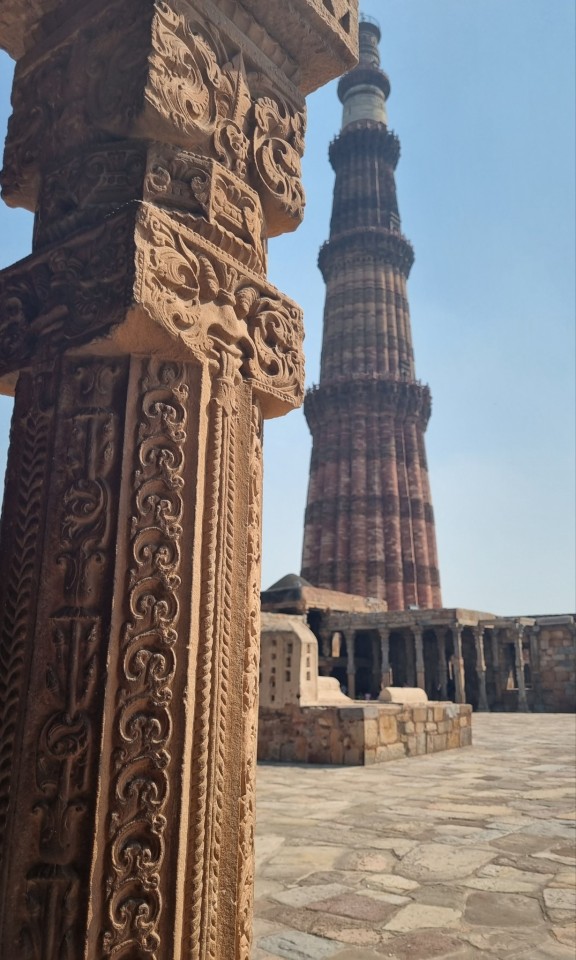


Please like or repost if downloading. Please give credit if you're sharing it online.
#qutub minar#history#monuments#dilli#delhi#new delhi#india#cultural#asia#delhi sultanate#mughals#mehrauli#qutub complex#indo islamic architecture#qutb ud din aibak#iltutmish#tughlaq dynasty#lodi dynasty#wallpaper#historical wallpapers#phone wallpapers#indian monuments#historical monuments#for you#trending#tumblr
10 notes
·
View notes
Photo
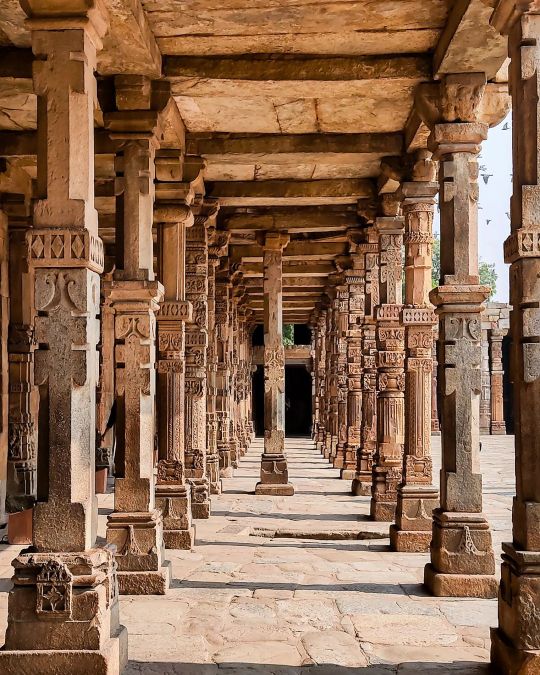
Carved pillar passage Qutub Complex The Indian Slave Dynasty (Mamluk Dynasty) lasted from 1206 to 1290, almost a century. The list of sultans is as follows Qutb ud-Din Aibak (1206 – 1210 AD) Aram shah (1210 – 1211 AD) Iltutmish (1211 – 1236 AD) Rukn-ud-din-Firoz (1236 AD) Razia al-Din (1236 – 1240 AD) Muiz-ud-din Bahram (1240 – 1242 AD) Ala-ud-din Masud (1242 – 1246 AD) Nasir-ud-din Mahmud (1246 – 1266 AD) Ghiyas-ud-din Balban (1266 – 1285 AD) Muiz-ud-din Muhammad Qaiqabad (1286 – 1290 AD) #qutubminar #delhi #worldheritagesite #history #carving #stonestructures #stonecarving #historyofindia #slavedynasty #lalkot #qutubcomplex #window #ancientmarvels #india #phonephotography #photography #mumbai #maharashtra #redsandstone #marble #delhidiaries #quwwatulislammosque # (at Qutub Minar) https://www.instagram.com/p/Cl2wjWHykQV/?igshid=NGJjMDIxMWI=
#qutubminar#delhi#worldheritagesite#history#carving#stonestructures#stonecarving#historyofindia#slavedynasty#lalkot#qutubcomplex#window#ancientmarvels#india#phonephotography#photography#mumbai#maharashtra#redsandstone#marble#delhidiaries#quwwatulislammosque
3 notes
·
View notes
Text
Some Places to Visit in North India
Ladakh, in northern India, is great for adventurers and nature lovers. Its breathtaking views of the Himalayas, deserts, and lakes like Pangong and Tso Moriri make it famous. Traditional Tibetan monasteries like Hemis and Thiksey dot the area. Outdoor activities including hiking, rafting, and biking. Ladakh's beauty, tranquilly, and vibrant culture make it an essential destination, especially in summer when the climate is temperate and suitable for exploring.
Agra Fort, a UNESCO World Heritage Site in India, showcases Mughal architecture. Emperor Akbar built the red sandstone fort in 1565 as a royal residence and military base. It has magnificent palaces, mosques, and gardens such Jahangir Palace, Khas Mahal, and Diwan-i-Khas surrounded by walls. The fort offers a stunning view of the Taj Mahal. Its role in Mughal rule and intrigue makes it a must-see for history buffs and tourists.
Qutub Minar, a UNESCO World Heritage Site in Delhi, India, is the world's tallest brick minaret at 73 meters. It marks the beginning of Muslim rule in India, built by Delhi Sultanate founder Qutb-ud-din Aibak in 1193. The five-story tower showcases Indo-Islamic architecture with Quranic carvings and phrases. The Qutub complex includes the minaret, Quwwat-ul-Islam Mosque, and Iron Pillar. The Qutub Minar, a symbol of India's rich history, remains a tourist attraction.
Please visit our website Trip Counselors for more information.

#agra taj mahal visit#jaipur agra#agra tour#delhi tour#delhi to taj mahal#kashmir leh ladakh#leh ladakh trip#kashmir leh ladakh trip#leh to ladakh trip#trip counselors#trip planner#tour planner#travel plan#plan my trip#vacation planner#solo trip#couple tour#travel with friends#tour and travel#itinerary planner#easy trip planners
0 notes
Text
Best Historical Tours in Hyderabad That Are Ideal for Young Children
Hyderabad, a city renowned for its historical sites and rich cultural legacy, provides young students with an abundance of engaging educational options. Preschoolers can have an engaging and instructive experience with Hyderabad's historic tour, which helps them develop an early appreciation for history and culture. This post discusses some of the top historical excursions in Hyderabad that are age-appropriate for young children and skillfully combine education with enjoyment.

The Charm of Hyderabad’s Historic Sites
Introducing preschoolers to history through engaging tours can be a delightful way to spark their curiosity and broaden their understanding of the world. These tours are designed to be interactive, ensuring that children remain engaged and learn while having fun.
Charminar: The Iconic Landmark
Charminar is one of the most recognizable landmarks in Hyderabad. This 16th-century mosque is a marvel of Indo-Islamic architecture and offers a great starting point for preschoolers.
What to Explore: The towering minarets and the bustling market around Charminar provide a sensory-rich experience. Children can learn about the history of the monument and its significance in Hyderabad’s culture.
Interactive Activities: Organize a simple treasure hunt or a photo safari where kids can identify different architectural features.
Salar Jung Museum: A Treasure Trove of Artifacts
The Salar Jung Museum houses one of the largest collections of art and artifacts in India, making it an excellent destination for young explorers.
What to Explore: With over 40,000 objects, including paintings, sculptures, and textiles, children can discover items from various cultures and time periods.
Interactive Activities: Engage children with a “museum bingo” game where they have to find specific items, such as a sword, a painting, or a statue.
Golconda Fort: A Fortress of Stories
Golconda Fort is a magnificent fortress with a rich history that dates back to the 13th century. This site is perfect for an adventurous day out.
What to Explore: The fort’s expansive grounds, acoustics, and architectural marvels offer numerous points of interest.
Interactive Activities: Plan a storytelling session where children can listen to tales of kings and battles that took place at the fort.
Qutb Shahi Tombs: A Glimpse into the Past
The Qutb Shahi Tombs are a cluster of tombs belonging to the Qutb Shahi dynasty. These structures are examples of beautiful Persian, Pashtun, and Hindu architecture.
What to Explore: Walking among the grand tombs, children can learn about the history and architectural styles of the era.
Interactive Activities: Create a drawing session where kids can sketch the tombs and share what they’ve learned about the rulers buried there.
Chowmahalla Palace: A Royal Experience
The Chowmahalla Palace, once the seat of the Asaf Jahi dynasty, is a splendid palace complex that showcases the grandeur of Hyderabad’s Nizams.
What to Explore: The palace’s opulent rooms, vintage cars, and royal artifacts provide a glimpse into the lives of the Nizams.
Interactive Activities: Host a mock “royal court” where children can dress up and learn about royal traditions and etiquettes.
Nehru Zoological Park: Combining History with Nature
While primarily a zoo, the Nehru Zoological Park also offers educational insights into conservation and the natural history of various species.
What to Explore: The zoo’s vast collection of animals and interactive exhibits can teach children about wildlife conservation.
Interactive Activities: Plan a guided tour where children can learn interesting facts about different animals and their habitats.
Benefits of Historic Tours for Preschoolers
Preschools in Hyderabad engage preschoolers in historic tours around Hyderabad offers several educational benefits:
Enhanced Learning: Children learn about history, culture, and architecture in an engaging and memorable way.
Development of Curiosity: Exploring new places and stories stimulates curiosity and encourages a love for learning.
Interactive Learning: Hands-on activities and interactive storytelling make learning fun and effective.
Utilizing Technology for Enhanced Learning
Using a school parent app can enhance the experience of these historic tours. Parents and teachers can share updates, photos, and educational materials through the app, keeping everyone informed and engaged.
Conclusion
Preschoolers in Hyderabad have a unique opportunity to combine fun and education with the historic tour. Young children can have a greater understanding and appreciation of history and culture by touring famous sites like the Charminar, Salar Jung Museum, Golconda Fort, Qutb Shahi Tombs, and Chowmahalla Palace. These trips not only increase their understanding but also encourage a passion for studying that lasts a lifetime. These ancient sites may be transformed into fascinating classrooms where history comes alive for the youngest students with careful planning and captivating activities.
Also Read: Quotes About Technology and Education
0 notes
Text
Top 3 Places to Visit in Delhi
Delhi, the vibrant capital of India, is a mesmerizing blend of the old and the new. With a rich historical past and a thriving present, Delhi offers a unique travel experience that showcases the country's cultural and historical essence. From ancient monuments to bustling markets and serene gardens, the city has something for everyone. Here are the top three places you must visit when in Delhi.
1. Red Fort (Lal Qila)

One of the most iconic symbols of India, the Red Fort is a UNESCO World Heritage Site and a must-see attraction in Delhi. Built by Mughal Emperor Shah Jahan in 1648, the Red Fort stands as a testament to the architectural grandeur of the Mughal dynasty. Its massive red sandstone walls enclose a complex of palaces, halls, and gardens, making it an excellent destination for history lovers.
Highlights: Lahori Gate, Diwan-i-Aam (Hall of Public Audiences), Mumtaz Mahal
Timing: Open every day except Monday
Tip: Don't miss the light and sound show in the evening that brings the fort's history to life.
2. Qutub Minar

Standing tall at 73 meters, the Qutub Minar is another UNESCO World Heritage Site and one of the most popular historical landmarks in Delhi. This magnificent minaret, built in 1193 by Qutb-ud-din Aibak, marks the beginning of Muslim rule in India. The complex surrounding the Qutub Minar is home to several other architectural wonders, including the Quwwat-ul-Islam Mosque and the Iron Pillar.
Highlights: Qutub Minar, Quwwat-ul-Islam Mosque, Alai Minar
Timing: Open all days
Tip: Visit in the early morning or late afternoon to avoid the crowds and enjoy the intricate carvings and inscriptions on the tower.
Read more
Unique Places to visit in Kerala
cheap places in delhi
Bryant Park Kodaikanal
Best Tourist Places in Bihar
Places To Visit In Kodaikanal
3. Humayun's Tomb

The grand Humayun's Tomb is another architectural marvel that must be on your list. Built in 1570, this tomb is the first garden-tomb on the Indian subcontinent and inspired the design of the Taj Mahal. Its blend of Persian and Mughal architecture, with symmetrical gardens and beautiful pathways, makes it a peaceful and scenic site to explore.
Highlights: Humayun’s Tomb, Charbagh garden, Isa Khan’s Tomb
Timing: Open all days
Tip: Spend time walking around the gardens and soaking in the serene atmosphere; it's a peaceful retreat from the city's hustle.
Conclusion
Delhi is a city that tells stories of its grand past while embracing the pulse of modern life. These top three places—Red Fort, Qutub Minar, and Humayun's Tomb—offer a glimpse into the rich history and stunning architecture of India. Whether you're a history buff, an architecture lover, or a curious traveler, Delhi's treasures are sure to captivate and inspire.
Read more
Things to see in Rajasthan
Most Bueatiful Places in miami florida
Historical Places to visit in Delhi
Best Places to visit in Mumbai
Baba Haji Ali Dargah Mumbai
0 notes
Text
Top Places to Visit in Delhi: A Comprehensive Guide
Delhi, the vibrant capital of India, is a city that seamlessly blends the ancient with the modern. With its rich history, stunning architecture, and diverse culture, Delhi offers an array of attractions for every type of traveler. If you're planning a trip to this dynamic city, here's a guide to the top places to visit in Delhi.
1. Red Fort (Lal Qila)
The Red Fort, a UNESCO World Heritage Site, is one of the most iconic landmarks in Delhi. Built by the Mughal Emperor Shah Jahan in the 17th century, this imposing red sandstone fort is a testament to Mughal architecture. The fort houses several exquisite palaces, mosques, and gardens, including the Diwan-i-Aam (Hall of Public Audience) and Diwan-i-Khas (Hall of Private Audience). The grandeur of the Red Fort makes it a must-visit place in Delhi for history enthusiasts and architecture lovers alike.
2. India Gate
India Gate, an impressive war memorial located in the heart of New Delhi, is a symbol of national pride. Designed by Sir Edwin Lutyens, this 42-meter-tall arch commemorates the soldiers who died in World War I. The monument is surrounded by lush lawns and is a popular spot for evening strolls and picnics. The India Gate area also offers beautiful views of the Rajpath and nearby government buildings, making it one of the top places to visit in Delhi for a leisurely outing.
3. Qutub Minar
The Qutub Minar, another UNESCO World Heritage Site, stands as a marvel of Indo-Islamic architecture. This 73-meter-tall minaret, constructed by Qutb-ud-din Aibak in the 12th century, is adorned with intricate carvings and inscriptions. The Qutub Minar complex also includes the Quwwat-ul-Islam Mosque and the Iron Pillar of Delhi, renowned for its rust-resistant properties. As one of the historical highlights of Delhi, the Qutub Minar is a must-see for those interested in ancient history and architecture.
4. Humayun's Tomb
Humayun's Tomb, the final resting place of Mughal Emperor Humayun, is a beautiful example of Mughal garden tomb architecture. Built in the 16th century, this tomb is surrounded by meticulously landscaped gardens and features an elegant octagonal design. The tomb’s architectural style inspired the construction of the Taj Mahal. Visiting Humayun’s Tomb provides insight into Mughal architectural advancements and is one of the top places to visit in Delhi for history buffs.
5. Lotus Temple
The Lotus Temple, renowned for its lotus-shaped architecture, is a Bahá'í House of Worship in Delhi. Completed in 1986, this stunning temple is known for its serene ambiance and beautiful gardens. It is open to people of all faiths and promotes the message of unity and peace. The Lotus Temple is a tranquil retreat in the bustling city and offers a unique spiritual experience, making it one of the top places to visit in Delhi.
6. Akshardham Temple
Akshardham Temple is a modern architectural marvel that showcases Indian culture and spirituality. Inaugurated in 2005, the temple complex includes intricately carved mandapams, a grand central dome, and a beautiful water show. The temple’s exhibitions and cultural performances offer visitors a glimpse into India’s rich heritage. Akshardham Temple is a must-visit place in Delhi for anyone interested in exploring Indian culture and spirituality.
7. Chandni Chowk
For a taste of Old Delhi, head to Chandni Chowk. This bustling market area is famous for its vibrant street food, traditional shops, and historical sites. From sampling delectable street food like parathas and jalebis to exploring the narrow lanes and ancient havelis, Chandni Chowk offers an authentic experience of Delhi’s historical and culinary heritage.
Conclusion
Delhi is a city of contrasts, where history and modernity coexist harmoniously. Whether you’re exploring grand historical monuments, enjoying spiritual tranquility, or indulging in local cuisine, Delhi has something for everyone. These top places to visit in Delhi offer a glimpse into the city's diverse attractions and are sure to make your visit memorable.
1 note
·
View note
Text
Places to Visit in Delhi: A Comprehensive Guide
Delhi, the capital city of India, is a vibrant blend of history, culture, and modernity. It is a city where ancient monuments stand proudly amidst bustling markets and contemporary buildings. Whether you're a history buff, a food lover, a shopaholic, or a nature enthusiast, Delhi has something for everyone. In this guide, we will explore the top places to visit in Delhi and highlight some of the exciting things to do in Delhi.

Historical Monuments
1. Red Fort
The Red Fort, also known as Lal Qila, is one of the most iconic landmarks in Delhi. Built by the Mughal Emperor Shah Jahan in the 17th century, this massive fort is made of red sandstone and is a UNESCO World Heritage Site. The fort complex houses several museums and showcases a stunning display of Mughal architecture. A visit to the Red Fort offers a glimpse into India’s rich history and heritage.
2. Qutub Minar
The Qutub Minar is another UNESCO World Heritage Site and is the tallest brick minaret in the world. This 73-meter tall tower was constructed in 1193 by Qutb-ud-din Aibak and is surrounded by several historical structures, including the Quwwat-ul-Islam Mosque and the Iron Pillar. The intricate carvings and the historical significance of the site make it a must-visit.
3. Humayun's Tomb
Humayun's Tomb is a magnificent garden-tomb and a UNESCO World Heritage Site. It was built in 1570 and is the first example of Mughal architecture in India. The tomb is set in a large garden and features beautiful Persian-style architecture. It is considered a precursor to the Taj Mahal and is a peaceful place to explore.
4. India Gate
India Gate is a war memorial dedicated to the Indian soldiers who lost their lives during World War I. This 42-meter tall archway is located in the heart of Delhi and is surrounded by lush green lawns. The structure is particularly stunning at night when it is beautifully illuminated. Visitors can take a leisurely stroll around the area and enjoy the vibrant atmosphere.

Religious Sites
1. Lotus Temple
The Lotus Temple is a Bahá'í House of Worship known for its unique lotus-shaped architecture. The temple is made of white marble and is surrounded by nine pools of water. It is open to people of all faiths and offers a serene and peaceful environment for meditation and reflection.
2. Akshardham Temple
The Akshardham Temple is a stunning Hindu temple complex that showcases the rich cultural heritage of India. The temple features intricate carvings, beautifully landscaped gardens, and a mesmerizing musical fountain show. The complex also includes an informative exhibition on Indian history and culture, making it a great place to visit with family.
3. Jama Masjid
Jama Masjid is one of the largest mosques in India and was built by Mughal Emperor Shah Jahan. The mosque can accommodate over 25,000 worshippers and is an architectural marvel with its impressive domes and minarets. Visitors can climb the southern minaret for a breathtaking view of Old Delhi.
Markets and Shopping
1. Chandni Chowk
Chandni Chowk is one of the oldest and busiest markets in Delhi. It is a chaotic yet charming place where you can find everything from traditional Indian clothing to electronics and street food. The narrow lanes are lined with shops selling spices, jewelry, textiles, and more. A visit to Chandni Chowk is incomplete without trying some of the famous street food, such as parathas, chaat, and jalebis.
2. Connaught Place
Connaught Place, often referred to as CP, is a bustling commercial and financial hub in Delhi. It features a circular market with shops, restaurants, and cafes. The area is known for its colonial-era architecture and is a popular spot for shopping and dining. Connaught Place is also home to several cinemas, making it a great place to catch a movie.
3. Dilli Haat
Dilli Haat is an open-air market that offers a unique shopping experience. The market is designed like a traditional Indian village and features stalls selling handicrafts, textiles, jewelry, and more from different states of India. Dilli Haat is also a great place to sample regional cuisines from various parts of the country.

Museums and Galleries
1. National Museum
The National Museum in Delhi is one of the largest museums in India and houses a vast collection of artifacts spanning over 5,000 years of history. The museum's exhibits include sculptures, paintings, coins, manuscripts, and more. It is a great place to learn about India's rich cultural heritage and history.
2. National Gallery of Modern Art
The National Gallery of Modern Art (NGMA) is a premier art gallery in Delhi that showcases contemporary Indian art. The gallery features works by renowned Indian artists, including Raja Ravi Varma, Amrita Sher-Gil, and M.F. Husain. The NGMA also hosts temporary exhibitions and art events, making it a must-visit for art enthusiasts.
3. Crafts Museum
The Crafts Museum, also known as the National Handicrafts and Handlooms Museum, is dedicated to preserving and promoting Indian crafts and handicrafts. The museum features a collection of traditional textiles, pottery, woodwork, and more. Visitors can also watch artisans at work and purchase handmade crafts from the museum shop.
Parks and Gardens
1. Lodhi Gardens
Lodhi Gardens is a beautiful park located in the heart of Delhi. The park is spread over 90 acres and is home to several historical tombs and monuments from the Lodhi and Sayyid dynasties. It is a popular spot for morning walks, picnics, and yoga sessions. The well-maintained gardens and serene atmosphere make it a perfect place to relax and unwind.
2. Nehru Park
Nehru Park is a large public park in the Chanakyapuri area of Delhi. The park features lush green lawns, flower beds, and walking paths. It is a popular spot for jogging, picnics, and cultural events. The park also hosts live music performances and yoga sessions, making it a lively and vibrant place to visit.
3. Garden of Five Senses
The Garden of Five Senses is a unique park located in the Saidul Ajaib village near Mehrauli. The park is designed to stimulate the five senses with its beautiful landscapes, sculptures, and installations. It features themed gardens, fountains, and a variety of plants and flowers. The Garden of Five Senses is a great place to relax and enjoy nature.
Modern Attractions
1. Hauz Khas Village
Hauz Khas Village is a trendy urban village in South Delhi known for its vibrant nightlife, art galleries, and cafes. The area is a blend of the old and the new, with historical ruins juxtaposed against modern boutiques and restaurants. Hauz Khas Village is a popular hangout spot for young people and a great place to experience Delhi's contemporary culture.
2. Kingdom of Dreams
Kingdom of Dreams is an entertainment and leisure destination located in Gurugram, just outside Delhi. The complex features live theater performances, cultural shows, and a boulevard showcasing the diverse cultures of India. The highlight of the Kingdom of Dreams is the Zangoora show, which is a Bollywood-style musical extravaganza.
3. Delhi Zoo
The National Zoological Park, also known as Delhi Zoo, is home to a wide variety of animals and birds. The zoo is spread over 176 acres and features well-maintained enclosures and lush green surroundings. It is a great place to spend a day with family and learn about wildlife conservation.
Conclusion
Delhi is a city that offers a perfect blend of history, culture, and modernity. From ancient monuments and bustling markets to serene parks and contemporary attractions, there is something for everyone in this vibrant city. Whether you are exploring the historical sites, indulging in delicious street food, shopping in bustling markets, or enjoying the green spaces, Delhi promises an unforgettable experience. So, pack your bags and get ready to explore the many places to visit in Delhi and discover the exciting things to do in this incredible city.
0 notes
Text
Exploring Delhi’s Hidden Gems: A Guide to Unseen Attractions
Introduction
Despite the tourist attractions, Delhi has so much more to offer to experiential travelers side from the ordinary cliche. For the purpose of exploring these less explored gems, the best way to opt for comfortable and flexible accommodation is to opt for hourly hotels in Delhi. They range from the famous places such as Nili Masjid and Tughlaqabad Fort to cultural locations such as Majnu Ka Tilla and Champa Gali through which this guide aims at introducing the city visitors to unseen sides of Delhi. Immerse yourself into the lesser seen parts of Delhi and capture the essence of history, culture and nature of the area.
Nili Masjid

Nili Masjid also known as Blue Mosque is a Lodi-era mosque near the Hauz Khas Market. Erected by Kausambi, a royal midwife of Sikander Lodi this mosque is so beautiful because of the ornamental shades of blue stones. Regarded as a national protected monument of India and is still used till today as a mosque, the entrance gate and the ribbed structure with the Wall have elegant carvings.
Malcha Mahal
Wilayat Mahal popularly known as Malcha Mahal is at Chanakyapuri. Originally this was constructed by Feroz Shah Tughlaq, as a hunting lodge in the early 1920’s and later on was occupied by the Royal Family of Oudh. thanks to the e passed in 2017 after the death of the last resident, the palace was thrown open to the public. Amidst rumors that it’s one of Delhi’s most haunted places, it will soon come under the ASI management.
Majnu Ka Tilla

The area known as Majnu Ka Tilla or MKT is known for its conscious market influence with relations to the Tibetan culture. Historically, men began stopping here after they heard that an Iranian Sufi had a meeting with Sikh Guru Devji in 1505. Some restructuring done in the past was in the place during the 1959 uprising where people of Tibetan origin settled down in this place toform some tone of Tibetan like feeling. Presently, the nickname MKT stands for a collection of odd cafes, trendy shops and amazing laphing. There is also a Buddhist temple which gives it a touch of Little Tibet.
Champa Gali
Champa Gali while evident said that it could be easily overlooked if one were only familiar with Delhi’s large shopping centers. It is indeed noteworthy that this area suits art lovers, gourmands, and buyers specifically the most. Graffiti decorate the buildings and the streets and the overall environment is extremely unwinding which is sooner recommendable for hanging. It is also a place for cultural activities, poetry evenings, and club of readers’ meetings.
Bhardwaj Lake

The Bhardwaj Lake is an offbeat natural place for the visitors within the Delhi territory and is situated in the Asola Bhatti Wildlife Sanctuary area. The lake was formed from the mining of sandstone and lime, it’s covered with the green vegetation and rich with butterflies and rabbits. The place is rather quiet, so it will appeal to those interested in nature and photography, as well as in finding a refuge from the noisy city.
Tughlaqabad Fort
Tughlaqabad fort is another historic structure commonly ignored by most tourists with features characteristic of the Tughlaq dynasty. The Qutb Minar was constructed in the 14th century, and it influences the current aspect of Delhi for the defense system. Some years back there was rumor that a saint cursed the place that is why it was partially abandoned. It is desirable to come to the fort to see it walking in the evening when the sun sets.
Jahaz Mahal

Jahaz Mahal or Ship Palace is said to be located nearer to Qutub complex at Mehrauli. This is because when mirror was placed in the venue , it gave an illusion of a ship on a lake. Constructed during the reign of Lodi dynasty, it was used to house travellers from different parts of the world. Phool Walon Ki Sair is celebrated in the month of October and for which, several floral events like processions and shows are carried out in the palace.
Conclusion
Tourism to the unknown parts of Delhi provides a novel view and tips the rich heritage of Delhi and hidden beauty spots thereby enhancing the tourism sector. These places range from beautiful and quiet lakes, archaeological sites, culturally dense residential areas, artist enclaves, among others, and are better than crowded tourist attractions. Mentioning this, it is possible to note that exploring the variability of the Indian capital with the help of convenient hourly hotels, one can easily occupy the hours in an interesting and rather creative way. Have a good time learning all those enriching and obscure aspects of Delhi that are in store for you on the trip.
0 notes
Text
Which is the Oldest Monument in Delhi?

The Qutub Minar, the oldest standing monument in Delhi, is a UNESCO World Heritage Site that dates back to the late 12th century. Commissioned by Qutb-ud-din Aibak, the founder of the Delhi Sultanate, the construction of this magnificent minaret was completed by his successor, Iltutmish. Standing at a staggering height of 73 meters, the Qutub Minar is made of red sandstone and marble, featuring intricate carvings and verses from the Quran.
The tower is part of the Qutub Complex, which also houses several other historically significant structures, including the Quwwat-ul-Islam Mosque, Alai Darwaza, and the Iron Pillar of Delhi. The complex reflects the rich history and architectural prowess of the early Islamic rulers in India.
A visit to the Qutub Minar offers a fascinating glimpse into Delhi's ancient past, making it a must-see for history enthusiasts and tourists alike. If you want to visit this monument with family or friends you can book our Tempo Traveller facility according to your group members.
#delhiplaces#tempotravelleronrent#tempotravellerhire#tempotravellerbooking#travel#actempotraveller#roadtrip
0 notes
Text
Unique Wedding Venues in Hyderabad for an Unforgettable Experience
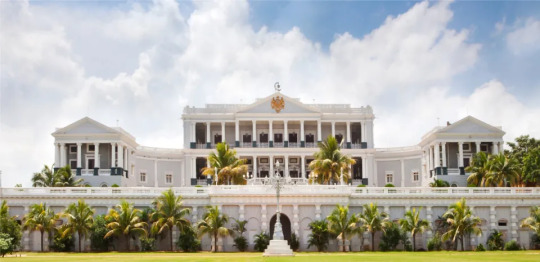
Unique Wedding Venues in Hyderabad for an Unforgettable Experience
Hyderabad, often known as the "City of Pearls," is a vibrant blend of historic grandeur and modern sophistication. This dynamic city offers a wide range of wedding venues that cater to different tastes and preferences. For couples seeking a unique and unforgettable wedding experience, Hyderabad has several extraordinary venues that promise to make your special day truly memorable. Here are some of the most unique wedding venues in Hyderabad that will leave you and your guests enchanted.
Click Here More Deatils:https://www.oppvenuz.com/services/venues/Hyderabad
Falaknuma Palace
Falaknuma Palace, a Taj property, is the epitome of royal elegance and opulence. Perched 2,000 feet above the city, this majestic palace offers a panoramic view of Hyderabad. Built in the 19th century, Falaknuma Palace exudes grandeur with its Italian marble staircases, Venetian chandeliers, and ornate furniture. The palace's Durbar Hall, with its intricate woodwork and stunning chandeliers, provides a regal setting for wedding ceremonies. A wedding at Falaknuma Palace is nothing short of a royal affair, ensuring an unforgettable experience for all.
Chowmahalla Palace
Another gem from Hyderabad’s royal past, Chowmahalla Palace is an architectural marvel that reflects the city's rich heritage. This palace, once the seat of the Asaf Jahi dynasty, is an ideal venue for a traditional and grand wedding. The palace complex features beautifully manicured gardens, ornate courtyards, and majestic halls that can be adorned with elaborate decorations. The palace's grandeur and historic charm provide a unique backdrop that will leave your guests in awe.
Shilparamam
For couples who appreciate art and culture, Shilparamam offers a unique venue that celebrates traditional crafts and arts. This cultural village, located in the heart of the city, provides an authentic and rustic ambiance with its mud huts, open-air amphitheaters, and lush greenery. Shilparamam offers a distinctive setting that combines cultural heritage with natural beauty, making it an ideal location for a traditional yet unconventional wedding.
Golkonda Fort
Golkonda Fort, a historic monument with a legacy dating back to the 16th century, offers a dramatic and unique setting for weddings. The fort's grand architecture, vast courtyards, and panoramic views of the city provide a breathtaking backdrop for a wedding ceremony. Imagine exchanging vows in a centuries-old fort under the stars – it’s an experience that blends history, romance, and grandeur.
Taramati Baradari
Taramati Baradari, an ancient pavilion with stunning views of the city, is a venue steeped in history and romance. Built during the reign of the Qutb Shahi dynasty, this venue offers an open-air amphitheater, lush gardens, and historic architecture. The venue's serene ambiance and historic significance make it a perfect choice for a wedding that blends tradition and elegance.
Fort Grand
Fort Grand is a luxurious venue that combines the grandeur of a fort with modern amenities. Located on the outskirts of Hyderabad, this venue features expansive lawns, grand halls, and beautiful courtyards. The fort-like architecture provides a majestic setting for weddings, while the modern facilities ensure a comfortable experience for guests. Fort Grand is ideal for couples looking for a grand and unique venue with a touch of luxury.
Ramoji Film City
For a truly cinematic wedding experience, Ramoji Film City offers a variety of themed venues that can be customized to suit any wedding theme. This massive film city, known for its diverse sets and landscapes, provides a range of options from lavish gardens and grand sets to elegant banquet halls. A wedding at Ramoji Film City can be as extravagant and imaginative as you desire, ensuring an unforgettable experience for you and your guests.
8. Mrugavani Resort and Spa
Mrugavani Resort and Spa, located near the Mrugavani National Park, offers a tranquil and eco-friendly wedding venue. Surrounded by natural beauty, this resort provides an idyllic setting with its lush lawns, elegant banquet halls, and luxurious cottages. The resort's commitment to sustainability and its serene ambiance make it a perfect choice for couples who want a green and peaceful wedding.
9. JRC Conventions and Trade Fairs
JRC Conventions and Trade Fairs is a versatile and grand venue that can accommodate large-scale weddings. This state-of-the-art convention center offers spacious halls, beautifully landscaped gardens, and modern amenities. The venue's flexibility allows for creative and elaborate wedding setups, ensuring a unique and memorable celebration.
10. Alankrita Resort
Alankrita Resort, located on the outskirts of Hyderabad, offers a charming and serene setting for weddings. The resort features beautifully landscaped gardens, traditional architecture, and a variety of indoor and outdoor venues. Alankrita Resort's blend of nature and traditional aesthetics creates a unique and picturesque backdrop for weddings, making it a favorite among couples seeking a tranquil and beautiful venue.
Conclusion
Hyderabad's diverse range of unique wedding venues ensures that every couple can find a location that reflects their personal style and preferences. From historic palaces and forts to cultural villages and luxurious resorts, the city offers something for everyone. These unique wedding venues not only provide stunning backdrops for your special day but also create an unforgettable experience that you and your guests will cherish for a lifetime. Whether you dream of a royal celebration, a cultural extravaganza, or a serene retreat, Hyderabad has the perfect venue to make your wedding dreams come true.
0 notes
Text
Unveiling India's Timeless Treasures: A Journey through Historical Marvels
India's history is a tapestry woven with threads of ancient civilizations, empires, and cultural exchanges. It is due to these ancient aspects that there are many historical places in India for us to visit. India's history is marked by a diversity of cultures, languages, religions, and traditions, each contributing to its rich heritage. It has witnessed the rise and fall of kingdoms, the spread of religions like Hinduism, Buddhism, Jainism, Islam, Sikhism, and Christianity, and the struggles for independence against colonial powers. Today, modern India stands as a vibrant democracy, embodying a synthesis of ancient traditions and contemporary progress and has left behind some of the Historical places in India for you to visit and explore.
Taj Mahal
One of the most prestigious amongst all historical places in India is The Taj Mahal, situated in Agra, India, is a world-renowned monument built by Mughal Emperor Shah Jahan in memory of his wife Mumtaz Mahal. Constructed from white marble adorned with intricate carvings and semi-precious stones, it took around 20 years to complete. The central mausoleum houses the tombs of Shah Jahan and Mumtaz Mahal, surrounded by a Persian-style garden. A symbol of eternal love and a UNESCO World Heritage Site, the Taj Mahal continues to captivate visitors with its timeless beauty and historical significance.
Agra Fort
The Agra Fort, located in Agra, India, is a UNESCO World Heritage Site and an architectural marvel. Among the other, it is also one of the most renowned historical places in India. Constructed primarily of red sandstone, it served as the main residence of the Mughal emperors until 1638. The fort's impressive structures, including palaces, mosques, and courtyards, showcase a blend of Islamic and Hindu architectural styles. Notable features include the Diwan-i-Am (Hall of Public Audience), Diwan-i-Khas (Hall of Private Audience), and the iconic Jahangir Palace. The fort's strategic location near the Taj Mahal adds to its historical significance, attracting visitors from around the world to admire its grandeur and rich history.
Red Fort
There are many historical places in India situated in Delhi itself and The Red Fort, located in Delhi, India is an important one. It is an iconic symbol of Mughal architecture and a UNESCO World Heritage Site. Constructed by Emperor Shah Jahan in the 17th century, it served as the main residence of Mughal emperors for nearly 200 years. Built primarily of red sandstone, the fort features impressive structures such as the Diwan-i-Am (Hall of Public Audience) and the Diwan-i-Khas (Hall of Private Audience), adorned with intricate marble inlay work and carvings. The fort's imposing walls and bastions enclose a sprawling complex of palaces, gardens, and pavilions, reflecting the grandeur and opulence of the Mughal era. Today, the Red Fort stands as a symbol of India's rich cultural heritage and attracts visitors from across the globe with its majestic architecture and historical significance.
Qutub Minar
The Qutub Minar is the vibrant tourism spot in historical places in India. It is located in Delhi, India, is the world's tallest brick minaret, standing at over 73 meters (240 feet) tall. Built in the early 13th century by Qutb-ud-din Aibak, the first ruler of the Delhi Sultanate, and later expanded by subsequent rulers, it is a UNESCO World Heritage Site. The minaret is constructed of red sandstone and marble, adorned with intricate carvings and verses from the Quran. The Qutub Minar complex also includes several other historical structures, such as the Quwwat-ul-Islam Mosque, Alai Darwaza, and Iron Pillar of Delhi. A testament to the architectural and artistic prowess of medieval India, the Qutub Minar continues to be a major tourist attraction, drawing visitors to marvel at its towering height and historical significance.
Hawa Mahal
The Hawa Mahal, or "Palace of Winds," is a distinctive architectural marvel located in Jaipur, Rajasthan, India. It is among the most prestigious structures in the historical places in India. Built in 1799 by Maharaja Sawai Pratap Singh, it is renowned for its unique facade adorned with intricately latticed windows (jharokhas) and balconies. The palace, constructed of red and pink sandstone, was designed to allow royal women to observe street festivals and daily life without being seen, hence its name "Palace of Winds." It is a very popular tourism spot in Jaipur with people visiting from all over the world.
0 notes
Text
Exploring the Historical Treasures of India
India, a land of diverse cultures, languages, and traditions, is a veritable treasure trove of historical wonders. From ancient temples to grand forts, India's historical places offer a glimpse into the rich tapestry of its past. Let's embark on a journey of Historical Places in India, traversing the length and breadth of this ancient land to discover its most enchanting historical places.
1. Taj Mahal, Agra
The Taj Mahal, one of the Seven Wonders of the World, is a symbol of eternal love. Built by Mughal Emperor Shah Jahan in memory of his beloved wife Mumtaz Mahal, this white marble mausoleum stands majestically on the banks of the Yamuna River. Its stunning architecture, intricate inlay work, and lush gardens make it a must-visit destination for travelers from around the globe.
2. Red Fort, Delhi
The Red Fort, a UNESCO World Heritage Site, is a powerful reminder of the Mughal era in India. Constructed by Emperor Shah Jahan in 1648, this red sandstone fort served as the main residence of the Mughal emperors for nearly 200 years. The fort complex is home to several museums, halls, and gardens that showcase Mughal architecture and the grandeur of India's historical past.
3. Qutub Minar, Delhi
Standing tall at 73 meters, Qutub Minar is the tallest brick minaret in the world and a fine example of Indo-Islamic architecture. Commissioned by Qutb-ud-din Aibak in 1192, this UNESCO World Heritage Site marks the beginning of Muslim rule in India. The minaret is surrounded by several other historically significant structures, including the Quwwat-ul-Islam Mosque and the Iron Pillar, known for its rust-resistant composition.
4. Amber Fort, Jaipur
Perched on a hilltop overlooking the Maota Lake, Amber Fort is a splendid blend of Hindu and Mughal architectural styles. Built by Raja Man Singh in the 16th century, the fort's intricate mirror work, ornate halls, and stunning courtyards make it one of the most visited historical places in Rajasthan. The fort's Sheesh Mahal (Mirror Palace) is particularly famous for its exquisite mirror mosaics and colored glasses.
5. Mysore Palace, Mysore
The Mysore Palace, also known as the Amba Vilas Palace, is a spectacular example of Indo-Saracenic architecture. It was the royal residence of the Wadiyar dynasty and is renowned for its grand durbar hall, intricate carvings, and beautifully painted ceilings. The palace is illuminated with nearly 100,000 light bulbs during the Dussehra festival, creating a breathtaking spectacle.
6. Khajuraho Temples, Madhya Pradesh
The Khajuraho Group of Monuments, a UNESCO World Heritage Site, is famed for its stunningly intricate temples adorned with erotic sculptures. Built between 950 and 1050 AD by the Chandela dynasty, these temples celebrate various aspects of life, including love and spirituality. The temples are divided into three groups: Western, Eastern, and Southern, with the Kandariya Mahadeva Temple being the largest and most ornate.
7. Hampi, Karnataka
Hampi, a UNESCO World Heritage Site, was once the capital of the Vijayanagara Empire. Its ruins are spread over a vast area, offering a glimpse into the grandeur of this medieval city. The Virupaksha Temple, Vittala Temple with its iconic stone chariot, and the Lotus Mahal are among the highlights of Hampi. The site is a paradise for history buffs and architecture enthusiasts.
8. Ajanta and Ellora Caves, Maharashtra
The Ajanta and Ellora Caves are among the finest examples of ancient rock-cut architecture in India. The Ajanta Caves, dating back to the 2nd century BCE, are renowned for their exquisite Buddhist murals and sculptures. The Ellora Caves, a mix of Buddhist, Hindu, and Jain temples, were carved between the 6th and 10th centuries CE. The Kailasa temple at Ellora is particularly noteworthy for its massive size and intricate carvings.
9. Sanchi Stupa, Madhya Pradesh
The Sanchi Stupa is one of the oldest stone structures in India and an important Buddhist pilgrimage site. Commissioned by Emperor Ashoka in the 3rd century BCE, the stupa's hemispherical dome houses relics of the Buddha. The ornate gateways (toranas) around the stupa depict scenes from the Buddha's life and the Jataka tales, offering insight into early Buddhist art and architecture. historical places in India not only serve as repositories of the past but also as a source of inspiration, offering a glimpse into the rich tapestry of the country's heritage
10. Jaisalmer Fort, Rajasthan
Known as the "Golden Fort" due to its yellow sandstone walls that shine brilliantly in the sunlight, Jaisalmer Fort is a living fort with a vibrant community residing within its walls. Built in 1156 by Rawal Jaisal, the fort's massive ramparts, intricately carved Jain temples, and the Maharaja's palace make it a fascinating historical site. The fort offers panoramic views of the surrounding Thar Desert.
Conclusion
historical places in India are not just remnants of the past; they are living testaments to the country's rich cultural heritage and architectural prowess. Each site has a unique story to tell, reflecting the diverse history and traditions that have shaped India over millennia. Exploring these historical treasures offers an unparalleled journey through time, allowing visitors to connect with the soul of India.
0 notes
Text
An Introduction to Hyderabad's Architectural Scene
Hyderabad, the historic city known for its rich cultural heritage and modern developments, boasts a vibrant architectural scene that blends tradition with innovation. From ancient monuments to contemporary skyscrapers, Hyderabad's architectural landscape reflects its diverse cultural influences and dynamic growth. Let's delve into an introduction to Hyderabad's architectural scene, highlighting key aspects and notable landmarks:

Historic Heritage: Hyderabad is home to a treasure trove of historic architectural marvels, including the iconic Charminar. Built in the 16th century, Charminar is a symbol of Hyderabad's heritage, featuring intricate Islamic architecture, minarets, and a bustling market at its base.
Qutb Shahi Tombs: The Qutb Shahi Tombs complex showcases the architectural legacy of the Qutb Shahi dynasty, with intricately carved tombs, domes, and arches set amidst landscaped gardens. This UNESCO World Heritage Site is a testament to Hyderabad's royal history and craftsmanship.
Falaknuma Palace: A masterpiece of Indo-Islamic architecture, Falaknuma Palace is a grand heritage structure known for its ornate interiors, marble staircases, and panoramic views of the city. The palace's architectural splendor reflects the opulence of the Nizams of Hyderabad.
Modern Marvels: Hyderabad's skyline is dotted with modern architectural marvels such as the Rajiv Gandhi International Airport, Cyber Towers, and the Hyderabad Metro Rail stations. These contemporary structures showcase innovative designs, sustainable features, and technological advancements.
Innovative IT Parks: HITEC City and Cyberabad are prominent IT hubs in Hyderabad, characterized by cutting-edge architectural designs in office complexes, tech parks, and innovation centers. The architecture in these areas reflects the city's status as a leading IT destination.
Cultural Centers: Hyderabad's architectural scene includes cultural centers like the Salar Jung Museum, Birla Mandir, and Ravindra Bharathi, each showcasing unique architectural styles and cultural significance. These centers promote art, history, and heritage preservation.
Residential Architecture: The city's residential architecture ranges from traditional Hyderabad-style homes with courtyard layouts and jali work to modern villas, apartments, and gated communities designed for contemporary living. Architects blend aesthetics with functionality to create comfortable living spaces.
Green Buildings: With a focus on sustainability, Hyderabad features green buildings and eco-friendly initiatives. Architects incorporate energy-efficient designs, green spaces, rainwater harvesting systems, and solar panels to promote environmental conservation.
Educational Institutions: Hyderabad's educational institutions boast architecturally striking campuses designed to inspire learning and creativity. Modern classrooms, libraries, and research facilities reflect innovative architectural concepts in academic environments.
Future Prospects: The architectural scene in Hyderabad is poised for further growth and innovation with upcoming projects in urban planning, smart cities, public infrastructure, and heritage conservation. Architects continue to push boundaries and contribute to the city's evolving built environment.
In conclusion, Hyderabad's architectural scene is a fascinating blend of heritage, modernity, and sustainability. From historic landmarks to contemporary structures, architects in Hyderabad play a pivotal role in shaping the city's identity and architectural legacy.
0 notes
Text
The 8 Beautiful Places to Visit in the Golden Triangle
The Golden Triangle Tour in India is a captivating journey spanning Delhi, Agra, and Jaipur, forming a triangle on the map. Each destination is steeped in rich history, cultural splendor, and architectural marvels. From the bustling streets of Delhi to the iconic Taj Mahal in Agra, and the majestic forts of Jaipur, this tour offers an immersive experience into India's diverse heritage and vibrant traditions. Discover the Mughal grandeur, Rajputana opulence, and modern Indian life, all in one exhilarating expedition.
Here are eight beautiful places you must visit while exploring the Golden Triangle:
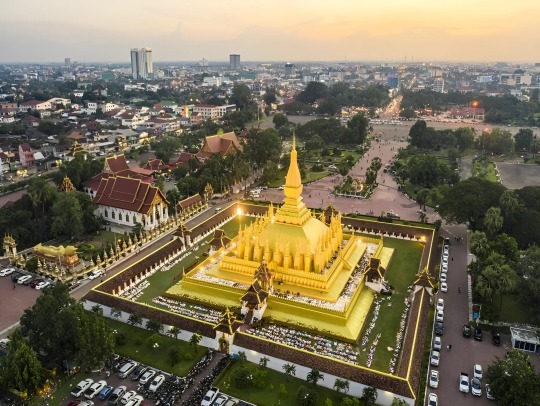
1. Taj Mahal, Agra:
One of the most iconic landmarks in the world, the Taj Mahal is a white marble mausoleum built by Mughal Emperor Shah Jahan in memory of his wife Mumtaz Mahal. Its beauty is unmatched, especially during sunrise and sunset.
Also Read: Kazakhstan tour package
2. Agra Fort, Agra:
A UNESCO World Heritage Site, Agra Fort is a massive red sandstone fort built by Emperor Akbar in the 16th century. It offers panoramic views of the Taj Mahal and houses several palaces, mosques, and gardens.
Also Read: Armenia tour package
3. Amber Fort, Jaipur:
Also known as Amer Fort, this majestic fort is located in Jaipur, Rajasthan. Built with red sandstone and marble, it overlooks Maota Lake and features stunning architecture, including the Sheesh Mahal (Mirror Palace).
Also Read: Georgia package
4. Hawa Mahal, Jaipur:
Translating to "Palace of Winds," Hawa Mahal is a unique five-story palace with a façade adorned with intricate latticework. Built in 1799 by Maharaja Sawai Pratap Singh, it allowed royal ladies to observe street festivals without being seen.
Also Read: Maldives tour package
5. City Palace, Jaipur:
This grand palace complex in the heart of Jaipur showcases a blend of Rajasthani and Mughal architectural styles. It houses museums, courtyards, gardens, and the Chandra Mahal and Mubarak Mahal.
Also Read: Sri Lanka tour
6. Qutub Minar, Delhi:
The tallest brick minaret in the world, Qutub Minar is a UNESCO World Heritage Site located in Delhi. Built in the 12th century by Qutb-ud-din Aibak, it is surrounded by several historically significant monuments.
Also Read: Hongkong tour
7. Humayun's Tomb, Delhi:
Another UNESCO World Heritage Site, Humayun's Tomb is the tomb of the Mughal Emperor Humayun. Built-in the 16th century, it is known for its Persian-inspired architecture and lush gardens.
Also Read: Hyderabad trip
8. Lotus Temple, Delhi:
Shaped like a lotus flower, this Bahá'í House of Worship is one of Delhi's most recognizable landmarks. It welcomes people of all religions to pray or meditate in its serene surroundings.
Also Read: Europe tour package
Conclusion
Embark on a mesmerizing journey through India's Golden Triangle tour, discovering its 8 breathtaking gems. From the majestic Taj Mahal to the vibrant streets of Jaipur, each destination enchants with its rich history and cultural splendor. Explore, immerse, and let the Golden Triangle weave unforgettable memories of beauty and wonder.
0 notes
